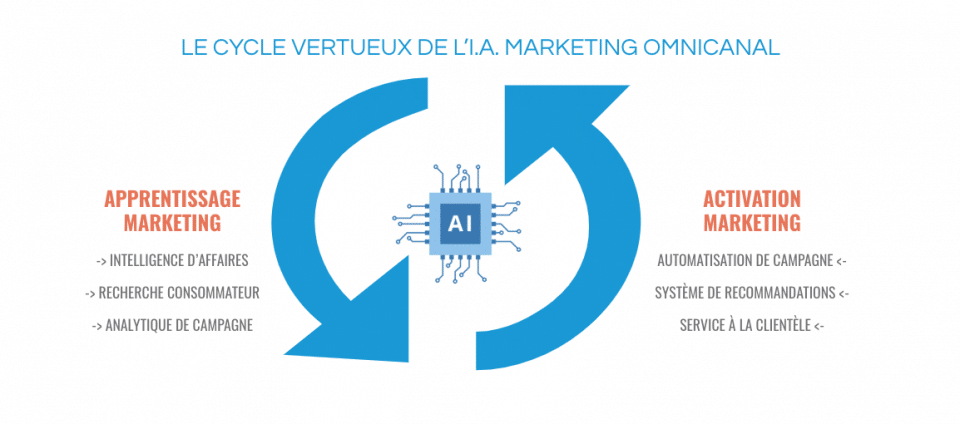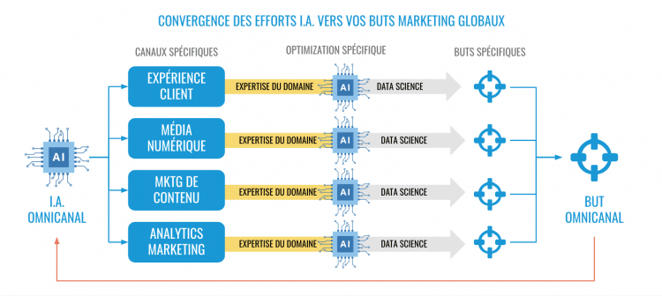Contributor
An Omnichannel Approach to Marketing AI
Contributor
REMARKETING ADS: THE STONE AGE OF AI IN MARKETING
Thanks to major self-serve advertising platforms like Google Ads and Facebook Ads as well as the advent of programmatic ad buying, marketers have been exposed to the use of AI in marketing for some time. However, the majority of machine learning related to these platforms takes place in a black box.
The advertising specialist grabs a piece of JavaScript code from the user interface of the advertising platform and copies the conversion pixel to a website. After a few months of advertising campaigns on the platform, the “magic” of marketing operates and the conversion rate increases by 20% year after year.
Similar “magic” happens with automation and email platforms from vendors like HubSpot and Salesforce. These platforms have a built-in AI option and allow marketers to perform scoring and qualification without the need to work directly with a data scientist.
More recently, web analytics platforms from Google and Adobe , and even data integration platforms like Datorama, a Salesforce company, have showcased innovative artificial intelligence capabilities. These solutions are less about marketing activation and more about identifying hidden insights in web analytics data.
AI BLACK BOXES CREATE BLIND SPOTS IN MARKETING
Having access to pre-integrated marketing AI capabilities in MarTech or Ad Tech platforms is fantastic. Thanks to these fairly easy-to-use features, marketers don't need a PhD in physics and computer science to excel at their job. People who understand cloud platform setups and have knowledge of JavaScript can say, in principle, that they are working with machine learning algorithms.
However, these features are in a black box, which means that we can (sometimes) see the result, but we don't understand what happened behind the scenes. Therefore, marketing managers often explain the results of their campaigns using phrases like: “the performance of lookalike audiences to the target audience found by the platform's algorithms is very satisfactory. This is excellent news! Unfortunately, if the Senior Manager asks for further details or information, we can often hear a pin drop in the meeting room.
Also, results from one platform's black box will, most of the time, not transfer to the rest of your marketing ecosystem. For example, when looking at overall marketing activities, it becomes difficult to explain how AI-powered Facebook Ads results relate to AI-powered email campaign results in HubSpot or Marketo. Even with a sophisticated attribution model, how can you use data from your advanced AI-enhanced Ad/MarTech platforms or analytics set to gain relevant insights and useful business intelligence? ?
The data deluge is likely to grow over the next few years as the MarTech landscape has grown from around 150 companies in 2011 to over 7,000 in 2019 (Source: chiefmartech.com ).
THE DOUBLE-EDGED SWORD OF BIG DATA
Let us now look at the challenges of Big Data in marketing. When we begin to combine all available metrics and dimensions in your marketing ecosystem, the challenge of processing data to pursue an omnichannel marketing strategy becomes apparent. If you somehow manage to create a data pipeline sophisticated enough to integrate all of your platforms into a single data warehouse or data lake , what happens next? What will you do with all this data? How can you process and exploit them in order to transform them into relevant business intelligence and extract knowledge?
It's the gift and the curse of Big Data for marketers. Proportionally, marketing departments probably hold the biggest mountains of data in their business. However, due to the magnitude and complexity of the data available, most CMOs and CMOs only benefit from a small portion of this data. Platforms like Google Analytics and Adobe Analytics are more likely to find at most 20% of potentially available insights within data from all activity recorded on your website. The question is, do you have the right analytics and business intelligence team to take advantage of your full data collection capabilities?
In 2018, eMarketer reported on a survey conducted by Blueshift and TechValidate , which focused on the challenges of making decisions based on customer data. 54% of respondents pointed out that their main obstacle is the inability to analyze and understand their data. Therefore, the majority of marketers make decisions based on a very incomplete customer profile.
Unfortunately, they are not even able to turn to advertising or media agencies for help. The reason is simple; most agencies struggle to do the data analysis themselves and are overwhelmed with data from multiple client accounts spread across multiple industries. According to another survey published by eMarketer in March 2019, the top concern for digital ad agencies across the world in the next two years will be acquiring data science and analytics skills. This statistic is not to be taken lightly.
The picture becomes increasingly clear; everyone is in pursuit of insights . Yet, without direct access to people with skills in analytics and data science , access to big data in marketing will inevitably become a problem rather than a benefit for businesses. As mentioned in an MIT Sloan Management Review article titled The Big Data Problem That Market Research Must Fix : “Big Data can support smart market research, but only if researchers adhere to the basics of understanding what they want to measure, and how they want to do it. »
Later in the article, the following is reported: “Making data-driven decisions based on poor quality metrics can be much worse than making data-driven decisions at all. On the other hand, companies and agencies that are able to find the key factors to analyze and interpret a large and complex data set will obviously enjoy a significant competitive advantage in the market.
Let the marketing arms race begin…

Big Data MR: The New Silver Bullet?
As if marketers needed yet another buzzword, the folks over at datadecision Group came up with one: “Big Data MR,” where MR stands for Market Research. Essentially, the term refers to the merger of three components: Big Data + Market Research/Consumer Insights + Predictive Analytics. They offer the following working definition of the term:
Big Data MR is the art and science of combining consumer data, behavioral data, attitudinal data and advanced analytics to produce better and faster decisions that yield superior business results.
Now, for the record, I don’t believe in silver bullets. The term is simply used as a reference in the subtitle to emphasize what will be the next hot pursuit of marketers who, as we all know, love to chase after silver bullet solutions and bright shiny objects. Except in this case, though Big Data MR might not be a literal silver bullet, it will nonetheless become a necessary tool to remain competitive over the next few years.
This was also true of remarketing ads when they first emerged about a decade ago. The early adopters of this technology gained an advantage over competitors who didn’t use programmatic remarketing. As the technology became democratized, the competitive edge went to those with the ability to do smarter remarketing campaigns. For example, more companies started using technologies like a DMP. More recently, there has been a major trend toward CDPs and Creative Management Platforms (CMPs).
In the coming years, Big Data MR can help marketers see further and faster with their marketing data to potentially achieve better business results or capture new opportunities for growth. An article called Reducing time to insight with AI posted by Think with Google stresses the importance of investing in your AI-enablement strategy, right now. Ultimately, Marketing AI and data science is about building models capable of analysing the whole customer experience across marketing channels. More importantly, these models need to draw insights from multiple data sources. Based on these research findings, AI can then effectively contribute to a truly competitive omnichannel marketing activation strategy, which leads to further insights… From there, the cycle goes on, ad infinitum.

The Imperative of Doing Omnichannel AI
Based on the coming challenges of Big Data marketing over the next few years, we’ve seen businesses speed up the pace toward developing data science and data engineering capabilities. What is gradually happening is a shift of attention from pre-baked/in-platform AI towards custom and business-specific AI models with an omnichannel approach.
As you continue to run the black box algorithms in your ad or email campaigns, the idea is to develop and train your own algorithms to reverse engineer insights, then bring it all together. The main business motivation is to excogitate AI-powered consumer insights from your data, from which you can improve your marketing strategy, optimize and automate global campaign efforts (not just Facebook Ads or HubSpot in silos) and feed business intelligence teams with new questions. When your team is able to operationalize your data at this level, you can declare your company to be well on its way in the journey toward fully augmented analytics.

Way back in 2017, McKinsey published a study showing how 60% of enterprises are in the process of adopting AI. According to Gartner (via Contentstack), by 2022, 50% of new digital business revenue streams will be discovered using machine-generated dynamic metadata. Where does your marketing department stand today with respect to those industry trends? Are you keeping up the pace? How many AI or data science projects are currently on the table in your company, division or team?
It should come as no surprise to find out, again according to Gartner, that Marketing AI was identified as one of the four most important emerging trends in marketing for 2020. From a marketing activation standpoint, AI is already gaining traction with automated content tagging and real-time personalization. However, as mentioned earlier, an even greater opportunity and concern is in leveraging data science and AI for deeper knowledge discovery and consumer insights analysis. The emerging field of Big Data MR will create new intersections of collaboration between the CX Expert, the Analytics Developer/Specialist and the Data Scientist/Engineer.
The combination of all three skill sets can provide the omnichannel marketer with the right balance between quantitative and qualitative analysis across channels, both online and offline. Naturally, achieving this capability implies an important learning curve for companies and organizations. Finding talent capable of materializing the above vision is a significant problem in the industry (as shown by the two Emarketer studies quoted earlier). Attracting CX Experts, Data Scientists/Engineers and Analytics Developers/Specialists to your noble business cause is hard enough. Getting all those good folks to work together and speak the same language is a whole other ball game.
Yet, for those who can design the right strategy and operational model to overcome those obstacles, omnichannel AI surely holds great promise for the near future. In order to take advantage of this new frontier of opportunities, the journey starts with a first step. There are countless machine learning or deep learning algorithms and use cases for marketing to choose from. How do you determine which models are relevant for your business needs? How can you test the waters of AI with small projects to reduce the steepness of the learning curve, while avoiding costly mistakes on large-scale projects (which could end up wasting hundreds of thousands or even millions of dollars in failed experimentation!)? Taking on large-scale AI projects without prior small projects under your belt is very risky. It could very likely lead you directly into the dreaded valley of dissolution in Gartner’s Hype Cycle.
A better and safer way to get started is simply by first organizing Marketing AI workshops with your teams. Invite people from different departments and pair them up with expert AI consultants in the field, then brainstorm about what data science could do for your business goals. Start identifying short- to long-term practical use cases with significant potential for impact. Set a preliminary roadmap with some milestones for this year as you gradually flesh out the way forward. Hire a firm already doing Marketing AI to run small projects with your existing data. Test, learn, refine and scale. With each step, you build increasingly more momentum until your reach the point of takeoff. The key thing is to focus more on what artificial intelligence will bring to your marketing strategy than on the AI strategy itself. Without a good grasp on the former, the latter is prone to failure.
If you need help setting up Marketing AI workshops or building a roadmap, Adviso has a team of data scientists who are also industry experts in marketing. We would be glad to work through the process with you, without breaking the bank in the process.








